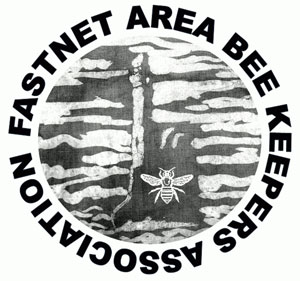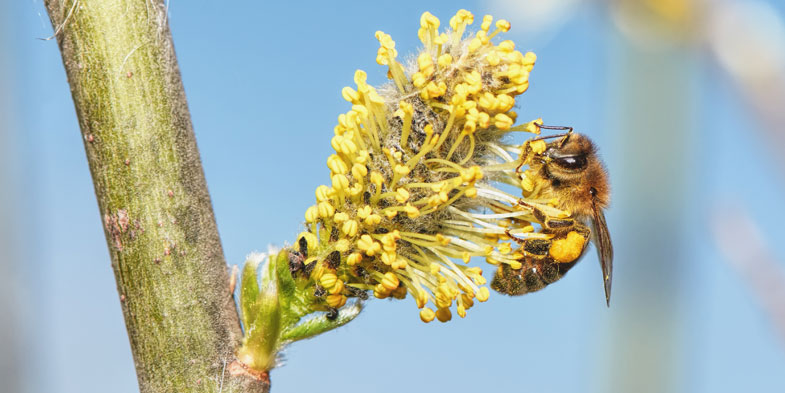Hello Beekepers!
We hope you and your bees have been enjoying the lovely weather! This month, we’ll look at what to do during that all-important first inspection of the season. We also have a live, in-person meeting in Ballydehob on Wednesday 20th April at 7.30pm, so scroll down to the bottom of this email for more details. We’re looking forward to seeing you all for a cup of tea and some bee chat!
First Inspections – Hooper’s Five
The clocks have moved on.
The daylight hours have lengthened.
The buds and flowers are emerging.
The temperatures are rising.
Queenie has started to lay.
The colony population is on the up.
The bees are out and about gathering food for themselves and for the emerging new bees while inadvertently pollinating and keeping things balanced ensuring the future longevity of the flora. So, from a beekeeping perspective, what should we be doing without tormenting the bees too much? Some of you may have already inspected your hive(s) and we hope that you found all the girls healthy and saw that queenie has started another year of egg laying.
For those of you who have yet to open the hive, the Hooper 5 checklist is a great barometer as to how the colony is coping and developing.
1 – SPACE
Are there enough empty cells in some of the frames in the brood chamber?
Space is needed for the rearing of the next generation of bees. Bee brood refers to the eggs, larvae and pupae of honey bees. The queen lays a single egg in the cells which have been cleaned by young domestic bees. She tends to lay in a circular or oval pattern.
The rearing of these new bees requires enormous amounts of food. The forager bees are out and about collecting nectar and pollen. When they return laden down with the goodies, they need empty cells to store this food. They also, of course, need food for themselves.
So, from a beekeeping perspective: ensure that there are enough empty cells/frames so that the girls can get on with the job of increasing colony numbers. Remember, these will be the future forager bees that will put the jar of honey on your kitchen table.
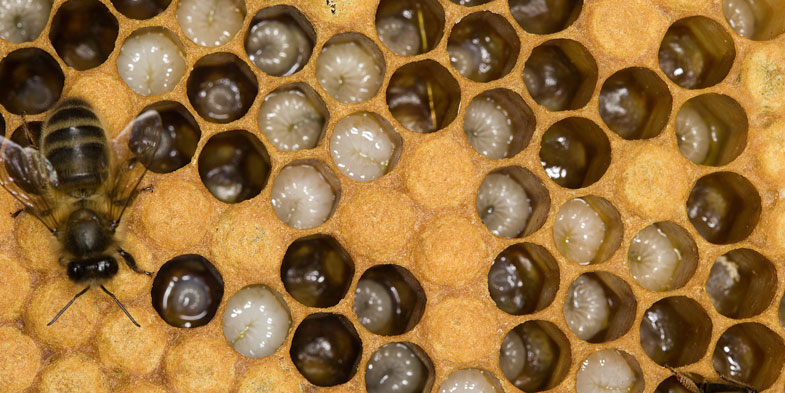
2 – QUEENRIGHT
Is there a good laying queen in the hive?
If you see some frames of brood and eggs, you can be almost 99% sure that queenie is alive, present and well. Don’t panic if she hides from you. Recognising eggs and being able to spot them in the frames is probably one of the most important tasks of any beekeeper and please don’t become disheartened if you have a little difficulty with this. For the members who have just started, we’ll spend time on this when you visit the apiary. As with most things, it gets easier with practice. For those of you who might be visually challenged (somewhat like myself), wear your reading specs or, for the sake of around 3 euro, the discount stores offer them for sale in up-to-date styles and colours!
My first yearly inspection is generally quick because the last thing I want to do is let the temperature of the brood nest decrease too much (i.e. the area that queenie is laying in and where the varying stages of developing brood is located). Bees regulate their nest temperature with high precision and like to maintain a temperature range of between 32 and 36 degrees celsius. This helps to ensure normal brood development. It’s always great if you catch a glimpse of her majesty and her ladies in waiting, and if this occurs I’ll mark her there and then. This will be covered later.
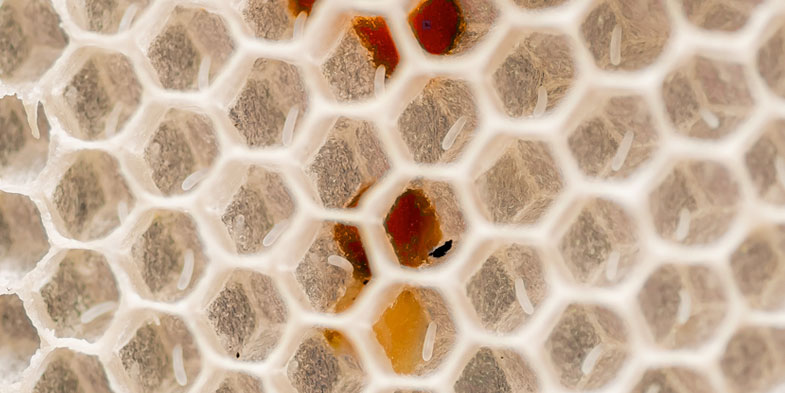
3 – DEVELOPMENT
On inspection, take note of how many frames of brood are present. This means if there’s sealed or unsealed brood on the frame. If you see this on both sides of the frame, this counts as one frame of brood. When I checked the girls sometime last week, they all had between two and three laid-up frames.
Get into the habit of keeping records, i.e. recording all of the Hooper 5 checklist. As you progress, you can record even more information, e.g. docility, steadiness on the frame, temperament, swarming impulse, etc. However, for now, paying close attention to the main 5 is more than adequate. If you’re like me, you’ll think that you’ll remember all of the details, but even with one or two hives I’ll have forgotten information in no time at all. As you become more experienced, the gathered record information will prove invaluable for lots of procedures.
4 – DISEASE
The dreaded disease section but we really need to be able to spot problems.
We live with Varroa.
Chalk brood is common too.
Keep reading and looking up images and get into the habit of sending your bees for disease checks. This service is free of charge and the details were posted in last month’s newsletter. Our An Beachaire magazine has all the details, too. I’ll write about how to gather bees for inspection next month.
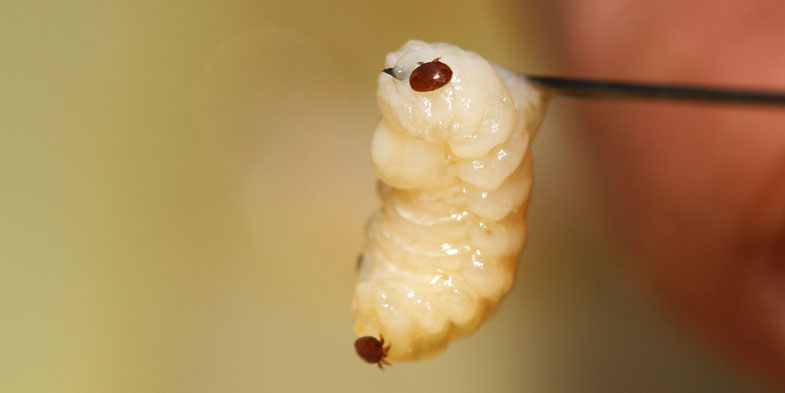
5 – STORES
Is there enough food to sustain the bees and the brood? Is there nectar, honey and pollen in cells for the rearing of the brood and for their own nutritional needs?
You may have fed your bees in early spring with fondant and some may even have fed sugar syrup later on, but during the busy later part of spring, the adult bees can survive almost exclusively on carbohydrates which are found in nectar and honey. Developing brood requires a more varied diet with adequate amounts of proteins, fats, minerals and vitamins. Pollen provides most of this. Good forage in your apiary environs makes even more sense so help it along by appropriate planting and not cutting back what already exists in our beautiful hedgerows and meadows.
Hopefully, our bees will soon be needing an attic extension to their home with the introduction of a super. We’ll cover that next month, too, but in the interim and if you find that there’s not enough space in the brood chamber, put on a queen excluder over the brood box and a super over that. Space never goes amiss this time of year pending on colony development, etc.
Marking the Queen
So, how do I mark the queen or, better still, how do I find her?
Some people have a wonderful ability for this while others are so-so. Maybe I’m one of the so-so’s! However, experience has taught me one thing for sure:
If I perchance catch a glimpse of herself in the first yearly inspection I’ll have a gadget known as a ‘Crown of Thorns’ (available from all beekeeping suppliers for a very small sum) close by. I’ll very gently place it over her and this holds her in position on the frame. I then mark her thorax with a marking pen. This enables me to put a little blob of paint on her back and she’ll be much more visible on the subsequent inspections.
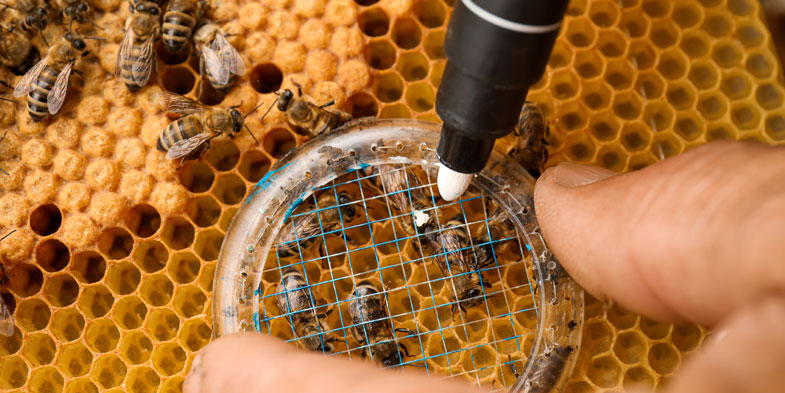
But I usually mark her on my second or third inspection. I go out to the apiary with only one thing on my mind – find and mark the queen. Nothing else. Better again, if someone comes with me it makes the task so much easier. Two pairs of eyes versus one pair! Locating the queen this time of year is so much easier because the population is much smaller, maybe 15–20,000 bees compared to 60–70,000 in mid summer. I generally don’t use smoke, therefore giving them little idea as to what is planned. I gently remove the roof and crown board while working from the back of the hive. The frames are running in the warm way, i.e. parallel to the entrance and I work from the frame nearest me. Once I know that queenie isn’t on this I leave this to one side of the hive. I now have that bit of extra space for manoeuvring the frames. I methodically work each successive frame scanning along the top bar and then scanning downwards – working in concentric circles. In your mind’s eye, keep visualising her – supermodel long and regal. Repeat this examination on the other side of the frame but make sure to work the frame directly over the brood box. You certainly don’t want her to fall to the ground. Yikes!
I become more observant as I near stores and brood. She could well be around this area. Handle the frames gently. I often find that the bees are very steady on the frames that she is on. As I’ve already mentioned, I generally use a crown of thorns, but be careful not to crush her when placing it on top of her on the frame. You already know that her and the workers and drones have three distinct body sections – head, thorax and abdomen. You mark the thorax. The yearly colour system is explained in last month’s newsletter. There are many devices for catching the queen but I find that this method is a good way for the less experienced beekeeper, and it’s wonderful when you have her marked because, as you progress through the year, it really makes a huge difference in your colony management. We’ll be doing a demonstration of this for our new students in the coming weeks.
Next month we’ll cover the “to do list” and the bits I missed out on this time.
Recipe – Honey Salad Dressing
Now that Spring has arrived we can look out for the ‘bitter herbs’ our bodies crave after the winter. Rocket leaves, allium leaves, baby mustards come to mind. But they can be bitter so a little sweetness makes a moreish pairing.
Salad Dressing (courtesy Christie Sanders)
1/4 c Olive oil
1 Tbl honey
2 Tbl apple cider vinegar
salt
1 Tbl toasted sesame seeds
Place everything in a bowl and whisk to emulsify. Then add some toasted sesame seeds.
TIP: Toast a cup of sesame seeds ahead. Handy to dip into as and when needed.
Coming Up – April Meeting in Ballydehob
Let me remind you again of this month’s lecture. We’re hosting an actual, real live meeting in Ballydehob Community Centre on Wednesday April 20, commencing at 7.30pm!
Our lecturer is a past president of FIBKA and a very experienced beekeeper and lecturer. He will be teaching us about ‘Swarm Control’, which is another vital skill. We here at FABKA look forward to seeing you all there. We’ll have a little raffle on the night if you choose to support and it’ll be followed by the important cuppa!
Regards and happy beekeeping,
Mairead Love & the team at FABKA
